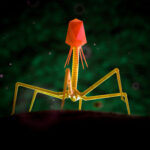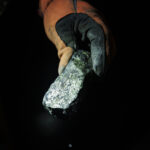Through Education and Research, a Second Life for Animal Contraband
In March, a California man with ties to Colombian drug lord Pablo Escobar was sentenced to 27 months in federal prison for attempting to sell a different type of highly-sought-after, and highly-illicit commodity — the horns of two black rhinos.
The trafficker, Edward Levine, had arranged with his partner to sell the horns, prized by many for their supposed medicinal properties and value as investment items, to an undercover agent with the U.S. Fish and Wildlife Service in Las Vegas. Levine’s case went to trial as part of Operation Crash — a criminal investigation by FWS and the Department of Justice into the country’s involvement in the black rhino trade.
Taken together with everything from elephant ivory to shark fins to live animals destined to be sold as pets, wildlife trafficking is one of the most lucrative illegal activities in the world. Trailing only behind narcotics, weapons, and human trafficking in terms of profit, the Defenders of Wildlife estimate that the trade brings in more than $20 billion each year, including $2 billion into the U.S. alone.
These sales are a major problem for conservation efforts, leading FWS to pursue 10,000 wildlife crime investigations each year.
And while it may seem too late for the 1.5 million pieces of contraband that sit inside the low, gray buildings of the Service’s National Wildlife Property Repository outside of Denver, Colorado, these items may still serve an educational purpose — and could even be used to help develop the tools needed to catch and prosecute traffickers.
While it may be too late for some animals, the confiscated mounts, skins, scales, and other items housed at the FWS National Wildlife Property Repository may still serve an important purpose.
At Seattle’s Woodland Park Zoo, teaching the public about wildlife trafficking often starts with simple exposure. Here in the facility’s shady Peacock Plaza, workers regularly engage with visitors not just about the live animals in the exhibits nearby, but also those in the wild that may be vulnerable to poaching.
Displaying contraband items on loan from FWS — including a sea otter pelt and a baseball cap made from lion skin — elicits mixed reactions from guests, says the zoo’s child and family program supervisor Jessie Maxwell.
“Some people are sad, some people are curious, some people are angry,” Maxwell says. These emotions can be a hook to start important conversations, like how poaching can affect both exotic animals as well as ones native to Washington State, like elk or bear.
“Here in Seattle, you’re not going to have a rhino [run] through your backyard or anything like that, but wildlife trafficking, poaching — this can all happen here, locally.”
Maxwell says that while these items aren’t the main way the zoo tries to inspire action — the living, breathing rhinos, lions, and gorillas are a bit more interesting to most guests — the cap, pelt, and other items can help the zoo deliver important messages that apply both at home and away: Don’t hunt without a license; avoid unlawful vacation souvenirs; be aware of species sold through the exotic pet trade; and know how to contact the state’s Department of Fish and Wildlife if you observe poaching or another wildlife crime.
“We’re hoping to offer a lot of different tips and tricks,” says Maxwell. “People who want to participate by voting, people who want to participate in their purchasing choices, people who want to make different recreational choices — we try to offer all of these things so that something will resonate within people’s lives.”
In early May, the zoo opened a temporary rhino exhibit, which also features messaging about poaching and the illegal wildlife trade, including information about how voters can impact local laws. In 2015, for instance, a ballot initiative pushed the state to pass the Washington Animal Trafficking Act, which granted state authorities greater power in regulating trade and punishing traffickers.
Whether in a zoo or in the wild, “every animal now is in human care,” Maxwell says, “because people’s choices impact the environment and therefore impact the animals.”
The lion skin baseball cap came from FWS to the zoo in 2015 — and the agency’s Colorado facility regularly loans out items to researchers, schools, and other organizations. According to Sarah Metzer, a staff member at the repository, FWS lent out more than 6,800 contraband items during the last 12 months.
“It is in the services’ best interest to make this material available to educators and researchers so that people can learn more about wildlife,” Metzer says.
“The actual wildlife objects provide audiences with a tactile experience than can help them connect and learn about species in a way that photographs and replicas cannot,” she added.
In addition to working with the public to raise awareness about poaching, FWS also maintains close relationships with museum workers to develop better ways of identifying trafficked animals. At the Field Museum in Chicago, specimens are shared both ways.
“Downstairs at the moment — it’s now 10 or 15 years since we accepted these specimens — are a puma and a caracal that were both seized by the Fish and Wildlife,” said Bruce Patterson, the museum’s curator of mammals. These animals were not requested as part of a specific project, but it’s hard to predict what use specimens might have in the future.
A leopard obtained by the Field Museum in 1994, for instance, was recently picked up in a research project about spot evolution. In total, the Field Museum is home to more than 30 million different specimens and objects.
The vast size of collections like these is invaluable to both the scientific community and — in a reciprocal twist — to wildlife law enforcement as well.
According to Ed Espinoza, deputy director of the FWS Forensics Lab in Ashland, Oregon, while the Service’s repository is full of head mounts or whole taxidermied animals, contraband coming into the country often arrives in smaller, more difficult to identify pieces.
“We don’t see a full elephant coming in through the L.A. port, we see either elephant skin or elephant toenails or ivory or teeth or whatever,” says Espinoza. “So our challenge is to identify species when all we have is bits of species.”
Take the armored, anteater-like pangolin — the world’s most trafficked animal. Last November, Chinese officials seized 13.1 tons of the creature’s scales, estimated to have come from 30,000 individual animals. If this shipment had been seized by FWS, the agency’s first step towards building a court case would be to prove they were, indeed, pangolin scales and not cow hoof or some other, non-protected material. In fact, earlier this year, FWS requested scale clippings from the Field Museum to test a new method of chemical identification. The Service needed a wider range of samples than they had on hand and the Field Museum, with its large collection, was able to help.
Patterson says it’s through these interactions that working relationships form, with the museum learning about new material and law enforcement learning about new projects or research.
“They have access to all of our material because we rely on their cooperation and, in a sense, they’re dependent in part on us to execute their responsibilities,” says Patterson. “So we’re all in this together.”
Espinoza echoed the importance of this relationship.
“For us, it’s invaluable,” he says. “When we’re challenged with identifying an evidence item, we need to access those collections to make a positive identification for a criminal prosecution.”


At other museums, too, researchers often work even more closely with law enforcement — including to develop tools that can make these identifications simpler and more accurate.
At New York City’s American Museum of Natural History, for example, George Amato, director of the Center for Conservation Genetics, has been refining a technique known as DNA barcoding, which allows researchers to identify species by comparing short, standardized sequences of DNA to a known library.
Borrowing confiscated items from FWS, including crocodile-skin handbags, boots, and wallets, Amato’s challenge is figuring out if DNA can be extracted even after the skin had been tanned and turned into leather.
“It turns out in many cases you can get usable DNA quite far downstream,” Amato says.
In addition to his own research, Amato has also worked with law enforcement agencies, such as the New York State Department of Environmental Conservation (DEC). He and his colleagues have tested the DNA of confiscated shark fins and dried seahorses from Asian markets, and even helped show that a bald eagle died after eating from a specific, poisoned goat carcass that had been left out as bait by testing the contents of its stomach. In total, Amato has been working with law enforcement for nearly 30 years.
“We feel that it’s our responsibility to work with these groups,” he said. “It’s a nice way of bringing our expertise to something that is of concern to general society.”
Major Scott Florence, head of New York DEC’s Bureau of Environmental Crimes Investigations Unit, confirmed that his department works with the AMNH, and other experts and institutions.
“Without these partnerships, wildlife crime investigations would be more complicated and more costly,” Florence says. “Coordinating with these experts helps law enforcement apprehend criminals looking to undermine wildlife conservation and helps us to preserve wild species in danger across the globe.”
James Gaines is a freelance science writer and journalist living in Seattle, Washington. He’s available on Twitter here.










